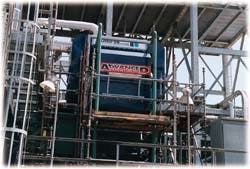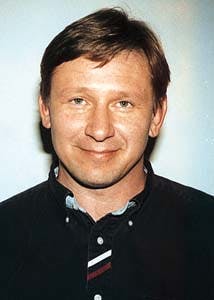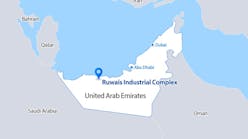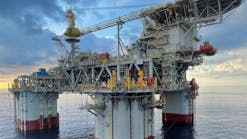Ron Mayers
Unifin International Inc.
Newark, Delaware
Koch's 5,500 hp motor with a WPII enclosure has been retrofitted with a motor cooler. The blue boxes hold the recirculation ducting and heat exchanger. The green box under the blue box is the motor where the windings are located (Fig. 1).A new motor-cooling process, developed by Unifin International Inc., a division of Koch Industries, debottlenecked Koch Refining Co.'s Corpus Christi, Tex., refinery by about 1,000 b/d.
In this first installation, Unifin retrofitted a water-to-air heat exchanger on the wet-gas compressor's existing 5,500 hp squirrel-cage, WPII (weather-proof enclosure) electric-induction motor while the motor was in operation (Fig. 1). The process dropped the operating temperature of the wet-gas compressor's electric motor on the fluid-catalytic cracking unit (FCCU) by 40° F.
The new process can be applied to any refining unit that uses a large electric motor rated at 1,000 hp or more.
Bottleneck description
Before the installation of the new motor-cooling process, the Koch refinery monitored the RTD (resistance temperature device) motor-winding temperatures of its 5,500 hp FCC electric motor. If the RTD winding temperature reaches more than 210° F., accelerated degradation of the winding insulation occurs, leading to motor failure.At winding temperatures greater than 210° F., the motor would have to be de rated. Thus, when the winding temperature approached 210° F., operators reduced the charge to the wet-gas compressor.
FCC capacity rates were reduced by about 1,000 b/d as a result of this bottleneck. In most cases, the bottleneck occurred during the hotter months when ambient temperatures were 85° F. or more. Corpus Christi daytime ambient temperatures are above 85° F. for about 6 months a year.
For the hotter months, Koch installed a 15-ton air conditioner with refrigeration ducting, which was routed into the air intake of the electric motor WPII enclosure. This resulted in a 1-2° F. RTD winding temperature drop. The air conditioner did not overcome the bottleneck because an RTD winding temperature reduction of 20-40° F. was required.
Electric motors are sized by their ability to expel waste heat caused by electrical and mechanical losses and their ability to operate without damage at elevated temperatures-limited by the rate at which they can dispose of waste heat.
Fig. 2 [90,829 bytes] illustrates the relationship of cooling air temperature to the motor output. Most motors are designed to operate up to 104° F., but if the cooling air is below this point, the equipment can deliver more power.
Design and installation
The heat exchanger and motor enclosure were installed while the 5,500 hp electric motor was in operation.Installation of the cooler involved placing the heat exchanger on the motor and connecting the air recirculation ducting. The installation of the cooler required only two 8-hr shifts.
This application required about 10 ft of clearance. Koch did not make any modifications to the motor enclosure. The cooler was custom-made to fit the motor.
The motor cooler uses a closed-loop water circulation system with a water chiller. Chilled water is circulated to the cooler. A 165° F. winding temperature was obtained with the chilled water (Fig. 3 [96,194 bytes]). The chiller was designed to fit a Class I, Division II, Group D electrical classification, which designates hydrocarbon in an explosion proof area.
The chiller, which is oversized, can provide additional cooling for this application if further motor cooling is desired. Its thermostat is set at 50° F., but it can be turned down to 40° F.
The cooler coil is composed of a tube bundle oriented to the motor shaft axis (Fig. 4 [280,324 bytes]). Heat is removed from the motor exhaust air as the air passes over the coil tubes. Effective motor cooling is derived by careful location of the tube bundle and the ability to precisely balance the air flow and pressure drop.
Koch also has an 11,000-hp electric motor for the main air blower of the FCCU and is currently evaluating motor cooling for this application. The installation of a second cooler can further add over 1,000 b/d of capacity.
Operating data
The motor cooler was commissioned on Mar. 27, 1998. The RTD winding temperature has averaged 165° F. ± 2° F. since the chiller water temperature has been maintained at 50° F.Fig. 3 shows winding temperatures before and after the motor cooling was installed. Before motor cooling, the winding temperature varied with the ambient temperature. With motor cooling, the winding temperature remains more constant.
Koch will receive the most benefit from the process during the summer. Fig. 3 shows RTD winding temperatures consistently over 200° F. for July 29, 1997, before motor cooling. On May 9, 1998, the ambient temperature was over 100° F. at Koch, but the RTD winding temperatures were no greater than 165.6° F.
Motor enclosures
The three most common types of motor enclosures are a weather-protected (WP) enclosure, a totally enclosed with air-to-air cooler (Teaac) enclosure, and a totally enclosed with water-to-air cooler (Tewac) enclosure.Motors with a WP enclosure, which are widely used, are not totally enclosed. A severe operating environment, as found in a refinery, can shorten a motor's service life.
Teaac enclosures are self contained. The drawback of the common round-tube, air-to-air coolers is their inherently poor heat-transfer efficiency as a result of the low specific heat of air. This necessitates large surface areas for removing the heat losses from a motor.
Consequently, a motor with round-tube, air-to-air coolers operates at a higher temperature air flow than it would with a water cooler or a WP enclosure. Such motors, as a result of inefficient air-to-air cooling, have to be derated up to 30% of the delivered hp. For example, to deliver 4,000 hp, the motor with a Teaac enclosure would have to be built to 5,200 hp.
If a standard round tube cooler of a Teaac motor were replaced by a twisted air cooler with greater heat-transfer capability, the motor would run cooler. In an existing motor, this lower temperature could be translated into more power. For a new motor, the twisted-tube cooler allows the purchase of a smaller motor. Unifin recently received a patent for a new twisted-tube Teaac design.
A Tewac enclosure uses a small cooler and the high specific heat of water to cool the motor air down to near the water temperature. In the case of Koch's example, a WP enclosure was converted to a Tewac enclosure.
The nameplate of the motor rated it at 5,500 hp. By retrofitting a Tewac enclosure and circulating chilled water, Koch rerated the motor to 6,100 hp, which is the maximum mechanical limit for the motor.
Extended life
The electric-motor industry estimates that the life of a motor will be doubled for every 18° F. reduction in operating temperature. Thus, the life of the Koch motor would be at least doubled using the Unifin cooler.The new cooler design, which totally encloses the motor, will greatly increase the life span and operational reliability of the motor. With complete enclosure, the motor achieves greater protection from airborne particulates, humidity, and chemical pollutants. The presence of these impurities causes deterioration of the insulation and windings, which affects the motor's performance and shortens its useful life.
Another benefit of Koch's new motor cooler is the constant motor temperature. Previously, Koch's WPII-type enclosure used ambient air for cooling of the motor. The motor-side air temperature rose and fell with that of the ambient temperature (Fig. 3). This thermal cycling can promote accelerated deformation of the windings insulation.
Economics
The cooler and chiller have a very fast payback. Increasing the capacity of an FCCU by 1,000 b/d results in a payback of less than 2 months. The pricing varies widely because each cooler is custom-built for the motor. Leasing is an alternative to avoid the capital expenditure of a cooler and chiller.Operation and maintenance costs of the cooler and chiller are more than offset by the savings in rewinding costs. Rewinding of the motor will be less frequent because the process doubles the life of the electric motor.
Installing a cooler/chiller combination increases the operating life and reliability of the motor, which decreases the chance of downtime. Most refiners do not keep spare FCCU air blowers or wet-gas compressor motors as a result of high inventory costs. In the event of a motor failure, downtime costs would be substantial since the refiner would have to rewind the motor or find an alternative motor. Downtimes can be as long as 4 weeks.
Without the new motor cooler, a larger motor is required to deliver the same horsepower. Capital costs are about three times higher for a larger motor than for a cooler/chiller combination. In addition, installation expenses of the new motor are usually high because of the large amount of civil work required.
Bibliography
Sheerin, Geoff, "A Cool Idea," Motors, Motor Controls & Drives, April 1997.Sheerin, Geoff, "Device and Method for Cooling a Motor," U.S. Patent Pending, Notification of allowance received, 1998.
The Author
Ron Mayers is technology manager for process optimization at Unifin International Inc., a division of Koch Industries. He specializes in heat-transfer technology for improving refining processes. Previously, he has held various positions at Koch Engineering Inc. and John Zink Co.Mayers holds a BS in mechanical engineering from Rutgers University, New Brunswick, N.J.
Copyright 1998 Oil & Gas Journal. All Rights Reserved.




